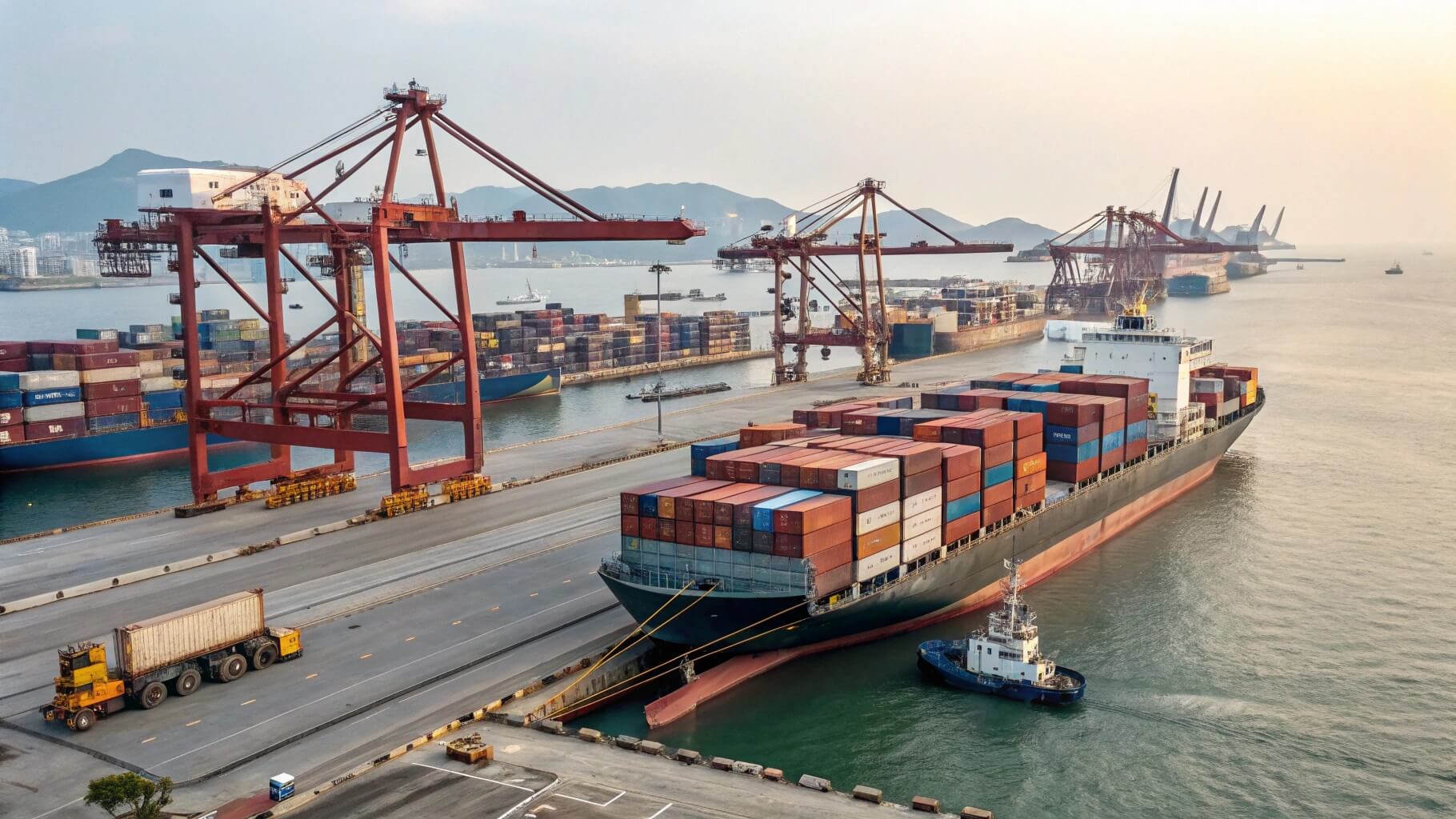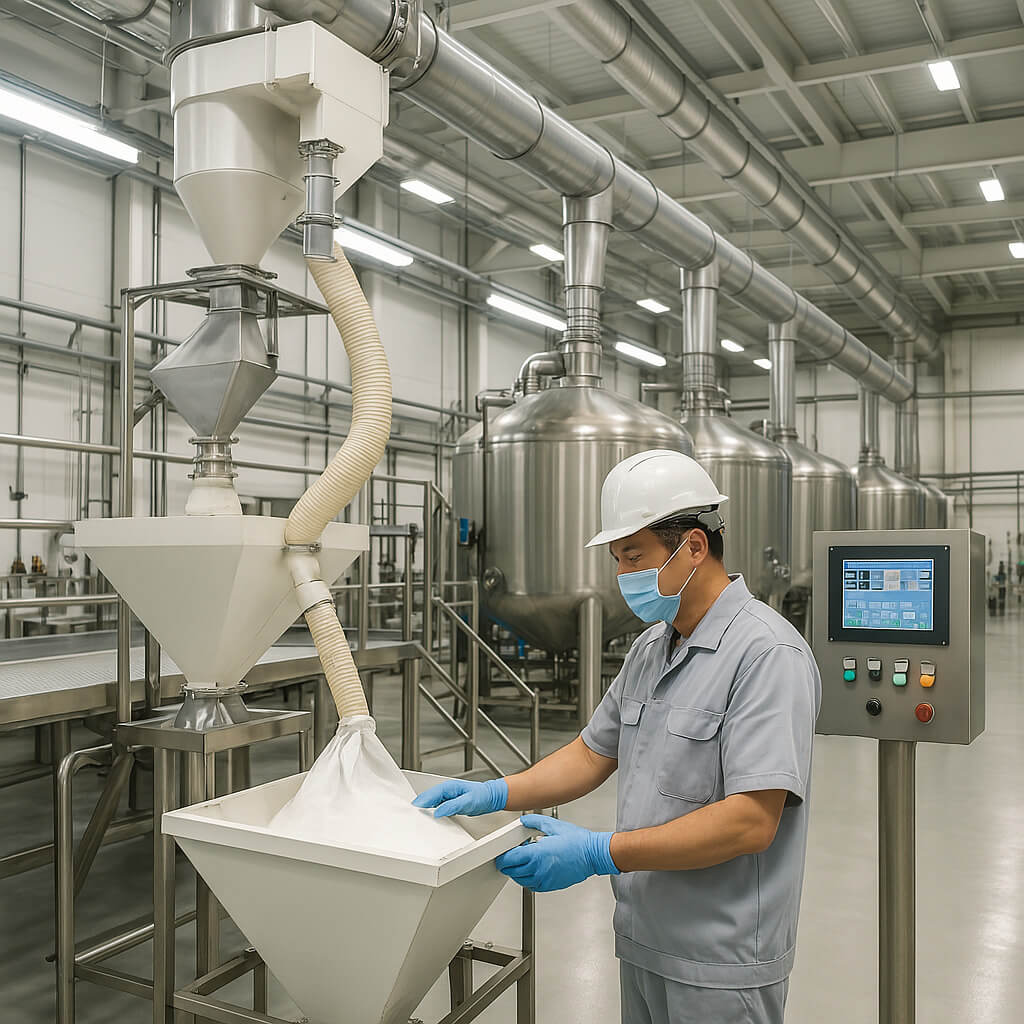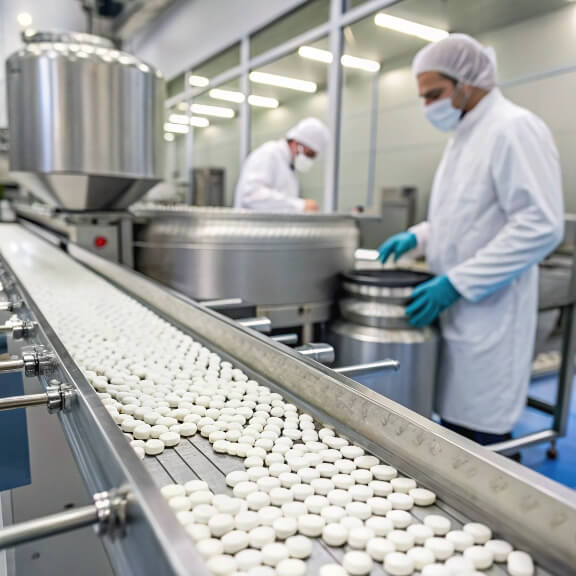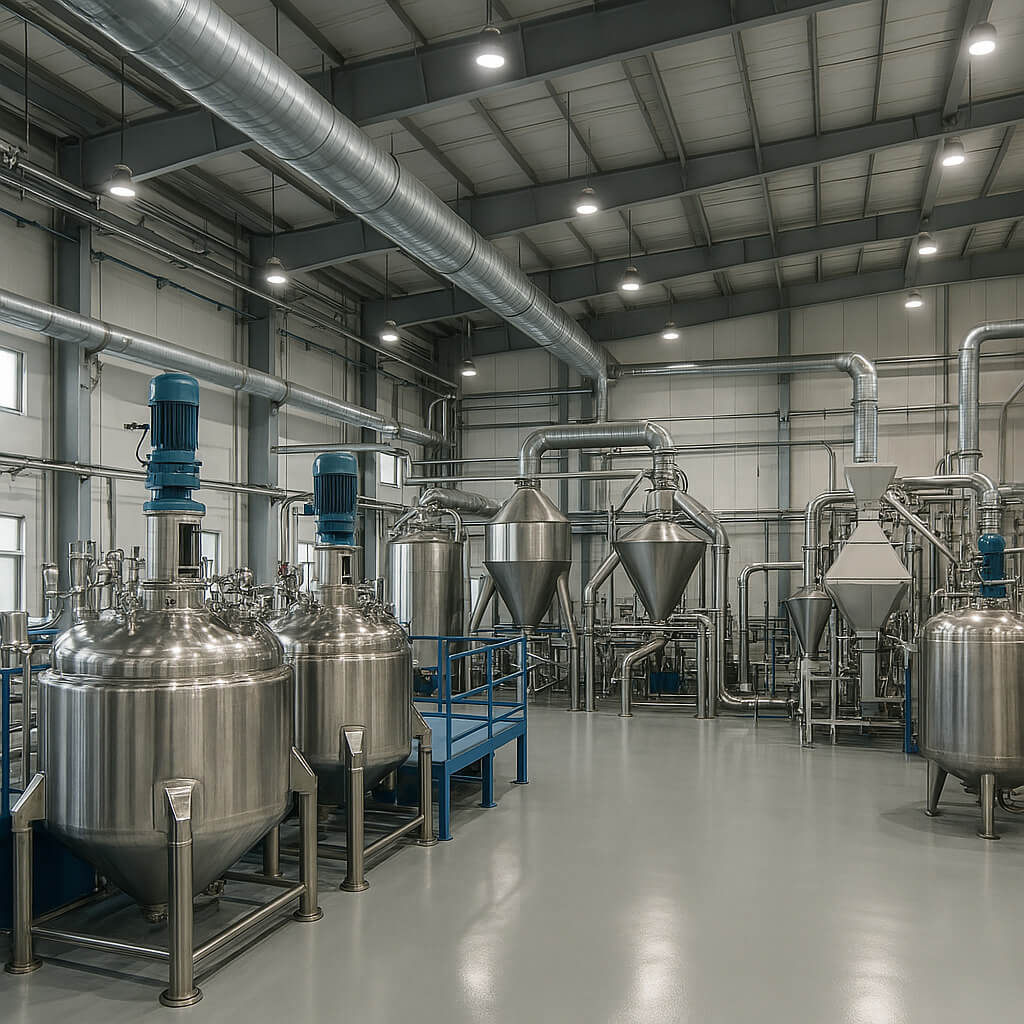Importador Hidroxipropilmetilcelulosa (HPMC) from China offers cost advantages and a reliable supply chain, but navigating supplier selection, quality control, and logistics can be overwhelming. Without proper planning, businesses risk delays, inconsistent product quality, and unexpected costs. So how can importers streamline the process?
A structured approach to importing HPMC from China involves supplier research, quality evaluation, price negotiation, logistics management, and regulatory compliance. Following a step-by-step process helps businesses minimize risks and ensure a smooth transaction.

A busy Chinese port showcasing container shipments, representing the export of HPMC to global markets.
China domina el mercado global de HPMC, making it a key source for international buyers. But why do businesses choose China for HPMC procurement, and what factors make it a strategic market? Let’s explore the industry landscape.
Why Import HPMC from China? Understanding the Market
China is the largest global producer of Hydroxypropyl Methylcellulose (HPMC), offering competitive pricing, large-scale production, and strong export infrastructure. But what makes China the preferred choice for international buyers?
Importing HPMC from China is cost-effective due to large-scale production, abundant raw materials, and established export networks. Chinese manufacturers provide high-quality HPMC that meets international standards, making them a reliable source for global buyers.
Key Reasons to Source HPMC from China
1. Cost Efficiency & Economies of Scale
- Costos de producción más bajos due to optimized industrial processes.
- Mass production capabilities reduce per-unit pricing.
- Incentivos gubernamentales support the chemical manufacturing industry.
2. Advanced Manufacturing & Quality Standards
- Los principales fabricantes chinos cumplen con USP, EP, JP y REACH certificaciones.
- Inversión en líneas de producción automatizadas ensures consistency and purity.
- Continuous R&D efforts lead to product innovations and performance improvements.
3. Stable Supply Chain & Export Readiness
- High production capacity ensures uninterrupted supply for bulk orders.
- Major ports (Shanghái, Ningbo, Qingdao) facilitate efficient global shipping.
- Fuerte logistics networks reduce lead times and supply chain disruptions.
Comparing HPMC Production: China vs. Other Countries
| País | Fortalezas | Debilidades |
|---|---|---|
| Porcelana | Cost-effective, large-scale production, strong export infrastructure | Algunos proveedores de nivel inferior pueden carecer de consistencia |
| Alemania | High purity production, strong R&D | High costs, limited production capacity |
| India | Growing supplier base, cost-effective | Inconsistencias de calidad, ineficiencias en la cadena de suministro |
| EE.UU | Strict regulatory compliance, high-grade HPMC | Expensive, lower production volume |
Why Global Buyers Prefer Chinese HPMC
- Consistent product quality with international compliance.
- Competitive pricing due to economies of scale.
- Fast and efficient shipping with global logistics support.
China dominance in the HPMC market makes it a strategic sourcing destination for buyers worldwide. But finding a reliable supplier is the first critical step in the import process. Let’s explore how to identify trusted manufacturers.
Step 1: Researching and Identifying Reliable HPMC Suppliers
Seleccionar lo correcto Hidroxipropilmetilcelulosa (HPMC) supplier is crucial for ensuring product quality, consistent supply, and competitive pricing. But with so many manufacturers in China, how can buyers identify reliable suppliers and avoid risks?
The key to finding a reliable HPMC supplier in China is conducting thorough research, verifying certifications, assessing production capacity, and evaluating customer reviews. A structured approach helps buyers minimize risks and establish long-term partnerships.
How to Research and Identify Trusted HPMC Suppliers
1. Use Multiple Sourcing Channels
- B2B Platforms: Websites like Alibaba, Made-in-China, and Global Sources list verified manufacturers.
- Industry Trade Shows: Events like World of Concrete y China International Chemical Industry Fair (ICIF) provide direct supplier connections.
- Google Search & Supplier Websites: Searching for "certified HPMC manufacturers in China" helps locate suppliers with strong online presence.
- LinkedIn & Industry Forums: Professional networks and business forums offer insights and recommendations.
2. Verify Certifications and Compliance
- Comprobar si hay Certificaciones USP, EP, JP y REACH para el cumplimiento internacional.
- Ensure the supplier has ISO 9001 quality management certification.
- Request a Certificado de análisis (COA) for product testing results.
3. Assess Production Capacity & Experience
- Los fabricantes establecidos tienen large-scale automated production lines ensuring batch consistency.
- Evaluar export history and customer references to gauge reliability.
- Look for suppliers with at least 5-10 years of experience in HPMC manufacturing.
4. Check Customer Reviews and Supplier Ratings
- Look for verified customer feedback on B2B platforms.
- Ask for references from other international buyers.
- Watch out for suppliers with frequent complaints about inconsistencies or delays.
Lista de verificación de evaluación de proveedores
| Criterios | Por qué es importante |
|---|---|
| Certificaciones y cumplimiento | Ensures regulatory approval and quality control. |
| Capacidad de producción | Prevents supply shortages and delays. |
| Customer Reviews & Reputation | Reflects real-world supplier performance. |
| Export & Logistics Capabilities | Ensures smooth international shipping. |
Banderas rojas que hay que evitar
- Unverified certifications – Indicates potential quality risks.
- Precios irrealmente bajos – May suggest lower-grade raw materials.
- Poor communication or delayed responses – Can signal operational inefficiencies.
Encontrar una reliable HPMC supplier in China requires thorough research and verification. Once potential suppliers are shortlisted, the next step is requesting samples and evaluating product quality. Let’s explore how to do this effectively.
Step 2: Requesting Samples and Evaluating Quality
Once potential Hidroxipropilmetilcelulosa (HPMC) suppliers in China have been identified, the next step is verifying product quality. Without proper evaluation, buyers risk sourcing inconsistent, low-quality, or non-compliant HPMC, which can impact performance in construction, pharmaceuticals, or food applications.
Requesting samples and conducting thorough quality tests help buyers assess batch consistency, viscosity, purity, and compliance with industry standards. This ensures the selected supplier can meet specific requirements.
How to Request and Evaluate HPMC Samples
1. Request Product Samples from Multiple Suppliers
- Contact at least three to five suppliers for comparison testing.
- Specify grade, viscosity range, and intended application when requesting samples.
- Ask for a Certificado de análisis (COA) y Hoja de datos de seguridad del material (MSDS) with the sample.
2. Key Quality Parameters to Test
- Viscosidad: Ensures proper consistency for the intended application.
- Pureza: High-quality HPMC should be free of contaminants.
- Contenido de humedad: Low moisture prevents degradation over time.
- Nivel de pH: Must fall within the correct range for chemical stability.
- Solubility & Dissolution Rate: Critical for pharmaceuticals and food-grade applications.
| Test Parameter | Acceptable Range | Por qué es importante |
|---|---|---|
| Viscosidad | 5,000 – 200,000 mPa·s | Determines flow and binding properties. |
| Pureza | ≥98% | Ensures consistent performance in applications. |
| Contenido de humedad | ≤5% | Prevents material degradation. |
| Nivel de pH | 5.0 – 8.0 | Maintains chemical stability. |
| Tasa de disolución | Quick & uniform | Essential for pharmaceuticals and food-grade HPMC. |
3. Conduct Laboratory or Application-Specific Testing
- HPMC de grado de construcción: Mix with mortar, tile adhesives, or cement to test workability.
- HPMC de grado farmacéutico: Perform dissolution and stability tests for tablet coatings.
- HPMC de grado alimenticio: Test thickening and emulsification properties in liquid formulations.
4. Compare Results and Select the Best Supplier
- Asegurar consistencia de lote a lote across multiple samples.
- Eliminate suppliers with high impurity levels, poor viscosity stability, or failed tests.
- Choose manufacturers offering formulaciones personalizadas to match specific industry needs.
Common Red Flags in HPMC Samples
- Inconsistent viscosity readings – Puede indicar un control de calidad deficiente.
- Contenido excesivo de humedad – Can lead to product degradation.
- Incomplete documentation – A lack of COA or MSDS raises compliance concerns.
By thoroughly evaluating sample quality and consistency, buyers can select un proveedor confiable de HPMC that meets their needs. The next step involves negotiating pricing and contract terms to secure the best deal.
Step 3: Negotiating Prices and Terms with Suppliers
After identifying reliable Hydroxypropyl Methylcellulose (HPMC) suppliers and verifying product quality, the next step is negotiating favorable pricing and contract terms. Poor negotiation can lead to hidden costs, unfavorable payment conditions, or supply chain risks.
Successful price negotiation involves understanding market rates, securing bulk discounts, clarifying payment terms, and ensuring long-term pricing stability. A well-structured agreement helps minimize risks and optimize procurement costs.
Key Strategies for Negotiating HPMC Prices
1. Understand Market Pricing Trends
- Investigación current HPMC market prices to establish a benchmark for negotiations.
- Compare pricing from multiple suppliers to avoid overpaying.
- Considerar seasonal price fluctuations that impact raw material costs.
2. Leverage Bulk Order Discounts
- Larger orders typically qualify for volume-based pricing reductions.
- Secure lower rates by committing to long-term contracts.
- Considerar group purchasing with industry partners to increase buying power.
3. Clarify Payment Terms and Conditions
- Common payment structures:
- T/T (Telegraphic Transfer): Standard for international trade.
- L/C (Letter of Credit): Ensures financial security for large transactions.
- D/P (Documents Against Payment): Reduces payment risk.
- Negotiate for partial upfront payments with balance due upon shipment.
4. Confirm Incoterms and Shipping Responsibilities
- Define responsibilities clearly using Incoterms 2020 como:
- FOB (Free on Board) – Buyer arranges shipping after goods leave the port.
- CIF (Cost, Insurance, and Freight) – Supplier covers shipping and insurance.
- DDP (Delivered Duty Paid) – Supplier handles all logistics and duties.
- Choose the Incoterm that aligns with your import strategy and budget.
Price Comparison Based on Order Size
| Order Size (Metric Tons) | Estimated Price per Ton (USD) | Potential Discount (%) |
|---|---|---|
| 1 - 5 MT | $3,200 - $3,500 | 0% - 3% |
| 5 - 20 MT | $3,000 - $3,200 | 5% - 8% |
| 20+ MT | $2,800 - $3,000 | 10%+ |
How to Avoid Common Pitfalls in Price Negotiation
- Watch out for hidden costs – Ensure pricing includes packaging, export fees, and shipping.
- Request a detailed cost breakdown – Identify unnecessary surcharges.
- Negotiate annual contracts – Ayuda lock in stable pricing and prevent market fluctuations.
Once pricing and terms are finalized, the next step is managing logistics and shipping from China to ensure timely delivery and cost-effective transportation.
Step 4: Managing Logistics and Shipping from China
Asegurando una reliable logistics and shipping process is critical when importing Hidroxipropilmetilcelulosa (HPMC) from China. Poor logistics planning can lead to delays, high shipping costs, and customs clearance issues, affecting business operations.
Effective logistics management involves selecting the right shipping method, ensuring proper packaging, handling customs documentation, and tracking shipments efficiently. Buyers must collaborate with experienced freight forwarders to streamline the process.
Key Steps for Managing HPMC Logistics and Shipping
1. Choose the Right Shipping Method
- Air Freight – Fast but expensive, suitable for urgent shipments.
- Sea Freight (FCL/LCL) – Cost-effective for bulk orders.
- FCL (Full Container Load) – Best for large orders (20ft or 40ft containers).
- LCL (Less than Container Load) – Economical for smaller shipments but may have longer transit times.
- Rail Freight – A middle-ground option for shipments to Europe via China’s Belt and Road Initiative.
2. Confirm Incoterms & Shipping Responsibilities
- FOB (Free on Board) – Supplier delivers to the port; buyer arranges shipping.
- CIF (Cost, Insurance, and Freight) – Supplier covers freight and insurance until the destination port.
- DDP (Delivered Duty Paid) – Supplier handles all shipping and customs clearance.
3. Ensure Proper Packaging & Labeling
- HPMC is typically packed in 25kg paper bags or jumbo bags for bulk transport.
- Asegurar embalaje resistente a la humedad to prevent degradation.
- Labeling must comply with import country regulations to avoid customs delays.
| Packaging Type | Capacity | Uso recomendado |
|---|---|---|
| 25kg Paper Bags | Small to medium orders | Common for pharmaceuticals and food-grade HPMC |
| 500kg – 1,000kg Jumbo Bags | Large bulk shipments | Cost-effective for construction-grade HPMC |
| Custom Packaging | Varía | Based on importer requirements |
4. Handle Customs Clearance & Documentation
- Required documents typically include:
- Conocimiento de embarque (B/L) – Proof of shipment.
- Certificate of Origin – Verifies product source.
- Packing List & Commercial Invoice – Details shipment contents and values.
- Customs Declaration Form – Required for import clearance.
- Work with an experienced customs broker to avoid compliance issues.
5. Track Shipments & Plan for Delays
- Usar real-time tracking systems for shipment visibility.
- Factor in potential delays due to port congestion, inspections, or customs clearance.
- Maintain buffer stock to prevent supply chain disruptions.
How to Avoid Common Shipping Issues
- Confirm logistics costs upfront – Avoid unexpected fees.
- Choose reliable freight forwarders – Experienced partners streamline customs clearance.
- Verify import regulations – Ensure compliance with destination country laws.
Once logistics are managed, the next critical step is ensuring compliance with regulatory requirements to avoid legal issues or import restrictions.
Step 5: Ensuring Compliance and Regulatory Requirements
Importador Hidroxipropilmetilcelulosa (HPMC) from China requires strict adherence to international regulatory standards. Failure to meet compliance requirements can lead to shipment rejections, legal penalties, or delays in customs clearance.
Ensuring regulatory compliance involves verifying certifications, understanding import restrictions, meeting safety standards, and preparing the necessary documentation. Buyers must work closely with regulatory agencies and customs brokers to ensure a smooth import process.
Key Compliance and Regulatory Steps
1. Verify Supplier Certifications
- Ensure HPMC complies with Normas USP, EP, JP y REACH for pharmaceutical and food applications.
- For industrial use, confirm compliance with ISO 9001:2015 para la gestión de la calidad.
- Solicitar informes de pruebas de laboratorio de terceros to validate purity, viscosity, and moisture content.
2. Understand Import Regulations by Region
- United States (FDA & USP Compliance)
- HPMC used in pharmaceuticals or food must meet FDA GRAS (Generally Recognized as Safe) standards.
- Cumplimiento de USP-NF (United States Pharmacopeia – National Formulary) required for medical applications.
- European Union (REACH & ECHA Compliance)
- Must be registered under REACH (Registration, Evaluation, Authorization, and Restriction of Chemicals).
- Cumplimiento de ECHA (European Chemicals Agency) regulations is mandatory.
- Other Markets (Local Regulations)
- Japón: Compliance with Japanese Pharmacopoeia (JP) para uso farmacéutico.
- India: Must be approved by the Food Safety and Standards Authority of India (FSSAI) for food applications.
3. Prepare Required Documentation
- Certificado de análisis (COA) – Confirms HPMC quality specifications.
- Hoja de datos de seguridad del material (MSDS) – Outlines handling and safety precautions.
- Customs Declaration Forms – Required for smooth import clearance.
- Food-Grade & Pharma-Grade Approvals – Additional documentation for edible and medical applications.
4. Conduct Third-Party Testing for Quality Assurance
- Arrange independent lab testing to validate supplier-provided data.
- Garantizar el cumplimiento de heavy metal limits, microbial safety, and viscosity consistency.
- Verify that HPMC meets end-use industry requirements before mass import.
Compliance Requirements by Industry
| Industria | Compliance Standard | Regulatory Body |
|---|---|---|
| Construcción | ISO 9001 | International Standards Organization |
| Productos farmacéuticos | USP, JP, FDA | USP, FDA, JP Pharmacopoeia |
| Alimentos y bebidas | FDA GRAS, FSSAI | FDA, FSSAI |
| Productos cosméticos | EU Cosmetics Regulation | European Chemicals Agency (ECHA) |
How to Avoid Compliance Issues
- Work with regulatory consultants to stay updated on import laws.
- Verify supplier documentation before finalizing contracts.
- Conduct pre-shipment inspections to prevent import rejections.
Meeting compliance and regulatory requirements asegura smooth customs clearance, legal importation, and risk-free market entry. Once compliance is secured, the final step is establishing a long-term partnership with a trusted Chinese HPMC supplier.
Step 6: Establishing Long-Term Partnerships with Chinese Suppliers
Successfully importing Hidroxipropilmetilcelulosa (HPMC) from China goes beyond securing a single shipment. Building a long-term partnership with a reliable supplier ensures consistent quality, stable pricing, and a streamlined supply chain for sustained business growth.
Establishing strong supplier relationships involves consistent communication, bulk order planning, supplier audits, and contractual agreements. A well-structured partnership benefits both parties by improving efficiency and reducing procurement risks.
Key Steps to Building a Strong Supplier Relationship
1. Maintain Open and Consistent Communication
- Establish clear expectations regarding quality, delivery schedules, and pricing.
- Usar multiple communication channels (email, video calls, WeChat, or WhatsApp) to improve responsiveness.
- Assign a dedicated procurement manager to oversee supplier relations.
2. Negotiate Long-Term Contracts for Stability
- Secure annual pricing agreements to avoid market fluctuations.
- Define minimum order quantities (MOQ) and bulk order discounts.
- Ensure contracts cover penalties for quality deviations or delivery delays.
3. Conduct Regular Supplier Audits and Quality Checks
- Schedule annual factory visits or third-party inspections.
- Llevar a cabo batch testing on received shipments to verify consistency.
- Establish a quality dispute resolution process to handle any deviations.
4. Leverage Supplier’s R&D Capabilities for Customization
- Work with manufacturers to develop specialized HPMC formulations for unique applications.
- Conversar nuevas innovaciones de productos to stay ahead of industry trends.
- Request technical support for improving product performance en diferentes aplicaciones.
5. Build Mutual Trust and Collaboration
- Offer reliable payment terms to strengthen trust.
- Conversar forecasting and demand planning to help suppliers optimize production.
- Maintain a long-term business mindset rather than focusing solely on short-term cost savings.
Benefits of Establishing a Long-Term Supplier Partnership
| Beneficio | How It Helps |
|---|---|
| Stable Pricing | Avoids market volatility and price spikes. |
| Priority Production | Ensures guaranteed supply during peak demand. |
| Customized Solutions | Tailored formulations to meet specific industry needs. |
| Reliable Quality | Minimizes batch variations and performance inconsistencies. |
| Faster Response Times | Strong relationships lead to better customer support. |
How to Avoid Common Supplier Issues
- Monitor supplier performance regularly to address any concerns early.
- Avoid switching suppliers frequently unless there are major quality or pricing issues.
- Ensure transparency in agreements to prevent misunderstandings.
Un fuerte supplier relationship results in a more efficient and cost-effective supply chain, allowing businesses to focus on growth and market expansion. With a structured import strategy and reliable supplier partnership, businesses can maximize the benefits of sourcing HPMC from China.
Now, let’s summarize the key takeaways for a successful HPMC import process.
Conclusion: Key Takeaways for a Successful HPMC Import
Importador Hidroxipropilmetilcelulosa (HPMC) from China presents significant opportunities, but success requires careful planning, supplier verification, and compliance with international standards. A well-structured approach ensures cost savings, product consistency, and long-term supply stability.
Key Takeaways for Importing HPMC from China
- China dominates the global HPMC market debido a cost-effective production, large-scale capacity, and strong export networks.
- Thorough supplier research is essential to avoid quality inconsistencies, hidden costs, and unreliable manufacturers.
- Requesting samples and performing quality evaluations help buyers confirm viscosity, purity, and compliance with industry standards.
- Negotiating pricing and contract terms asegura favorable bulk discounts, transparent payment structures, and stable supply chains.
- Efficient logistics and customs management prevent shipping delays, unexpected costs, and regulatory issues.
- Compliance with global safety and quality standards is non-negotiable for smooth customs clearance and risk-free market entry.
- Establishing long-term supplier partnerships garantías consistent quality, reliable supply, and business growth opportunities.
Final Thought
By following a step-by-step import strategy, businesses can secure high-quality HPMC from trusted Chinese manufacturers while minimizing risks. If you’re ready to import HPMC para construcción, productos farmacéuticos, alimentos o aplicaciones industriales, connect with industry-leading suppliers today to start your procurement process.
Preguntas frecuentes
¿Quién es el proveedor de HPMC en China?
China has multiple Hidroxipropilmetilcelulosa (HPMC) suppliers, including large manufacturers and trading companies. Leading suppliers hold Certificaciones USP, EP, JP y REACH and export globally. Buyers should evaluate certifications, production capacity, and customer reviews before selecting a supplier.
¿El HPMC está aprobado por la FDA?
HPMC es Generalmente reconocido como seguro (GRAS) por el Administración de Alimentos y Medicamentos de los Estados Unidos (FDA) para uso en pharmaceuticals and food products. However, manufacturers must comply with specific FDA regulations and Good Manufacturing Practices (GMP) for their products to be legally imported into the U.S.
¿Cuáles son los diferentes grados de HPMC?
El HPMC se clasifica en función de viscosidad, pureza y aplicación:
| Grado HPMC | Solicitud |
|---|---|
| Grado de construcción | Used in tile adhesives, cement-based plasters, and self-leveling compounds. |
| Grado farmacéutico | Found in tablet coatings, capsules, and controlled drug release formulations. |
| Grado alimenticio | Used as a thickener and stabilizer in dairy products, gluten-free foods, and sauces. |
| Grado cosmético | Enhances texture and stability in skincare products, lotions, and shampoos. |
| Grado industrial | Applied in coatings, adhesives, and specialty formulations. |
Each grade has different propiedades físicas y químicas, making it essential to choose the right one based on industry requirements.
¿Qué es mejor, CMC o HPMC?
La elección entre Carboximetilcelulosa (CMC) y Hidroxipropilmetilcelulosa (HPMC) Depende de la aplicación:
| Propiedad | HPMC | CMC |
|---|---|---|
| Retención de agua | Alto | Moderado |
| Adhesión | Fuerte | Más débil |
| Efecto espesante | Moderado | Más alto |
| Capacidad de formación de películas | Excelente | Limitado |
| Aplicaciones | Construction, pharmaceuticals, coatings, food | Alimentos, detergentes, papel, textiles. |
HPMC es preferred in construction, pharmaceuticals, and coatings for its film-forming and water-retention properties, whereas CMC is commonly used in food, detergents, and paper manufacturing.




